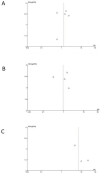Novelty in the gut: a systematic review and meta-analysis of the gastrointestinal manifestations of COVID-19
- PMID: 32457035
- PMCID: PMC7252994
- DOI: 10.1136/bmjgast-2020-000417
Novelty in the gut: a systematic review and meta-analysis of the gastrointestinal manifestations of COVID-19
Abstract
Background: The COVID-19 epidemic has affected over 2.6 million people across 210 countries. Recent studies have shown that patients with COVID-19 experience relevant gastrointestinal (GI) symptoms. We aimed to perform a systematic review and meta-analysis on the GI symptoms of COVID-19.
Methods: A literature search was conducted via electronic databases, including PubMed, Embase, Scopus, and Google Scholar, from inception until 20 March 2020. Data were extracted from relevant studies. A systematic review of GI symptoms and a meta-analysis comparing symptoms in severe and non-severe patients was performed using RevMan V.5.3.
Results: Pooled data from 2477 patients with a reverse transcription-PCR-positive COVID-19 infection across 17 studies were analysed. Our study revealed that diarrhoea (7.8%) followed by nausea and/or vomiting (5.5 %) were the most common GI symptoms. We performed a meta-analysis comparing the odds of having GI symptoms in severe versus non-severe COVID-19-positive patients. 4 studies for nausea and/or vomiting, 5 studies for diarrhoea and 3 studies for abdominal pain were used for the analyses. There was no significant difference in the incidence of diarrhoea (OR=1.32, 95% CI 0.8 to 2.18, Z=1.07, p=0.28, I2=17%) or nausea and/or vomiting (OR=0.96, 95% CI 0.42 to 2.19, Z=0.10, p=0.92, I2=55%) between either group. However, there was seven times higher odds of having abdominal pain in patients with severe illness when compared with non-severe patients (OR=7.17, 95% CI 1.95 to 26.34, Z=2.97, p=0.003, I2=0%).
Conclusion: Our study has reiterated that GI symptoms are an important clinical feature of COVID-19. Patients with severe disease are more likely to have abdominal pain as compared with patients with non-severe disease.
Keywords: abdominal pain; diarrhoea; epidemiology; gastrointestinal pathology; infectious diarrhoea.
© Author(s) (or their employer(s)) 2020. Re-use permitted under CC BY-NC. No commercial re-use. See rights and permissions. Published by BMJ.
Conflict of interest statement
Competing interests: None declared.
Figures




References
-
- World Health Organization Coronavirus disease (COVID-19) outbreak. Available: https://www.who.int
-
- Centers for Disease Control and Prevention Cases in the US. Available: https://www.cdc.gov
Publication types
MeSH terms
LinkOut - more resources
Full Text Sources
Medical
